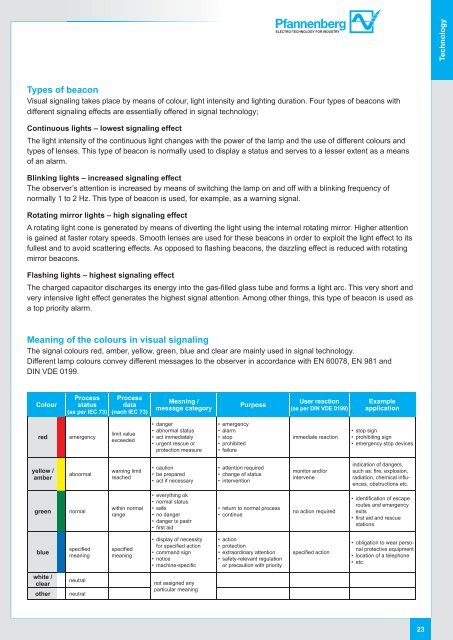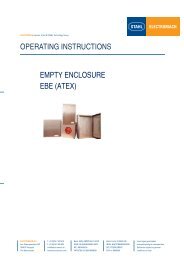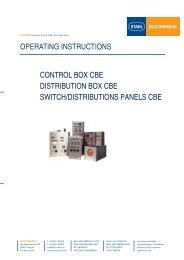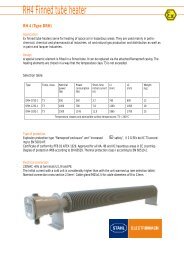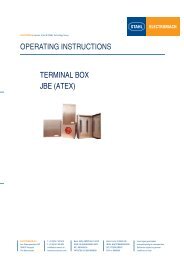You also want an ePaper? Increase the reach of your titles
YUMPU automatically turns print PDFs into web optimized ePapers that Google loves.
ELECTRO-TECHNOLOGY FOR INDUSTRY<br />
Technology<br />
Types of beacon<br />
Visual signaling takes place by means of colour, light intensity and lighting duration. Four types of beacons with<br />
different signaling effects are essentially offered in signal technology;<br />
Continuous lights – lowest signaling effect<br />
The light intensity of the continuous light changes with the power of the lamp and the use of different colours and<br />
types of lenses. This type of beacon is normally used to display a status and serves to a lesser extent as a means<br />
of an alarm.<br />
Blinking lights – increased signaling effect<br />
The observer’s attention is increased by means of switching the lamp on and off with a blinking frequency of<br />
normally 1 to 2 Hz. This type of beacon is used, for example, as a warning signal.<br />
Rotating mirror lights – high signaling effect<br />
A rotating light cone is generated by means of diverting the light using the internal rotating mirror. Higher attention<br />
is gained at faster rotary speeds. Smooth lenses are used for these beacons in order to exploit the light effect to its<br />
fullest and to avoid scattering effects. As opposed to fl ashing beacons, the dazzling effect is reduced with rotating<br />
mirror beacons.<br />
Flashing lights – highest signaling effect<br />
The charged capacitor discharges its energy into the gas-fi lled glass tube and forms a light arc. This very short and<br />
very intensive light effect generates the highest signal attention. Among other things, this type of beacon is used as<br />
a top priority alarm.<br />
Meaning of the colours in visual signaling<br />
The signal colours red, amber, yellow, green, blue and clear are mainly used in signal technology.<br />
Different lamp colours convey different messages to the observer in accordance with EN 60078, EN 981 and<br />
DIN VDE 0199.<br />
Colour<br />
Process<br />
status<br />
(as per IEC 73)<br />
Process<br />
data<br />
(nach IEC 73)<br />
Meaning /<br />
message category<br />
Purpose<br />
User reaction<br />
(as per DIN VDE 0199)<br />
Example<br />
application<br />
red<br />
emergency<br />
limit value<br />
exceeded<br />
• danger<br />
• abnormal status<br />
• act i<strong>mm</strong>ediately<br />
• urgent rescue or<br />
protection measure<br />
• emergency<br />
• alarm<br />
• stop<br />
• prohibited<br />
• failure<br />
i<strong>mm</strong>ediate reaction<br />
• stop sign<br />
• prohibiting sign<br />
• emergency stop devices<br />
yellow /<br />
amber<br />
abnormal<br />
warning limit<br />
reached<br />
• caution<br />
• be prepared<br />
• act if necessary<br />
• attention required<br />
• change of status<br />
• intervention<br />
monitor and/or<br />
intervene<br />
indication of dangers,<br />
such as: fi re, explosion,<br />
radiation, chemical infl u-<br />
ences, obstructions etc.<br />
green<br />
normal<br />
within normal<br />
range<br />
• everything ok<br />
• normal status<br />
• safe<br />
• no danger<br />
• danger is pastr<br />
• first aid<br />
• return to normal process<br />
• continue<br />
no action required<br />
• identifi cation of escape<br />
routes and emergency<br />
exits<br />
• fi rst aid and rescue<br />
stations<br />
blue<br />
specified<br />
meaning<br />
specified<br />
meaning<br />
• display of necessity<br />
for specifi ed action<br />
• co<strong>mm</strong>and sign<br />
• notice<br />
• machine-specific<br />
• action<br />
• protection<br />
• extraordinary attention<br />
• safety-relevant regulation<br />
or precaution with priority<br />
specifi ed action<br />
• obligation to wear personal<br />
protective equipment<br />
• location of a telephone<br />
• etc.<br />
white /<br />
clear<br />
other<br />
neutral<br />
neutral<br />
not assigned any<br />
particular meaning<br />
23


